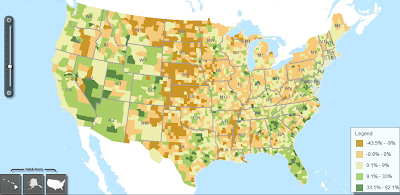Our colleagues at the Rural Blog have a piece on USDA's Atlas of Rural and Small-Town America tool. Like the Census maps generated by the New York Times, this tool helps communities like those in Appalachia understand more about themselves–which can be helpful for planning what they want to be in the future.
The story from the Jon Hale, at the Rural Blog:
Atlas of Rural and Small-Town America has demographic, economic and agricultural data

Population change, 2000-2009 (click on map for larger image)
The U.S. Department of Agriculture has unveiled a new rural mapping tool aimed at making county-level demographic, economic and agricultural data more easily available. The tool, labeled the Atlas of Rural and Small-Town America, encompasses more than 60 statistical indicators, which USDA hopes rural communities can use to spur economic development, Lynda Waddington of the Iowa Independent reports. "The new atlas will … help policy makers pinpoint the needs of particular regions, recognize their diversity and build on their assets," said Agriculture Secretary Tom Vilsack, who noted that the project is a part of a "broad USDA initiative to make relevant data easily accessible" to the public, researchers, journalists, public officials and other professionals.
The data is grouped into four categories: people, jobs, agriculture and county typologies. The "people" category encompasses county demographic profiles such as age, race/ethnicity, education, family composition, population change, migration and immigration. The "jobs" category displays "conditions and trends affecting the labor force, such as employment change, unemployment, industry and occupational structure," Waddington writes. Indicators of farm structure and demographic data about farm size, income, sales and tenure are available in the "agriculture" category. "County typologies" data include USDA Economic Research Service "county classifications based on the rural-urban continuum, economic structure and other key locational features, such as landscape amenities, occupation types, persistent poverty or population loss statistics," Waddington writes. (Read more)
Farm payments per operator in parts of Arkansas, Mississippi and Tennessee





